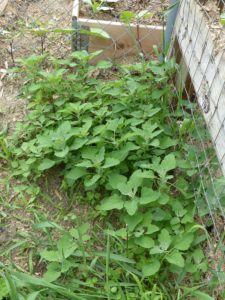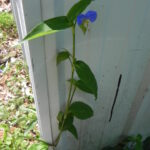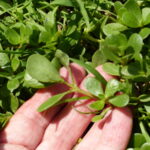Eatin’ Weeds
We don’t just pull weeds. We eat them!
Every summer gardeners spend hours pulling, digging, and spraying weeds that pop up overnight and grow like – Weeds! Marion’s family, especially grew up eatin’ weeds. Raised on a small, hardscrabble New Hampshire farm where the biggest crop was rocks, her family of seven supplemented produce with wild foods. Her dad, of the Depression era, knew the wild plants. So, she grew up eatin’ weeds and picking wild berries.
At the nature center in Kansas Rich was always looking for unique programs to present and wild edibles were a hit. Using the Euell Gibbons and Adrienne Crowhurst wild food guides, we learned which foods have the highest returns: easy to gather and process, moderately difficult yet rewarding, and survival-only foods.
We also realized that many are as tasty and nutritious as intentionally planted crops.
Dozens of weed species are edible, but we especially enjoy eating lambs quarter, purslane, and Asian dayflower that we haven’t planted but harvest from our garden. All were introduced from faraway continents and have gone wild. Each is easy to identify.
Lambs quarter

Lamb’s Quarters readily grow in disturbed soil.
This Eurasian native plant has many names. It’s sometimes called lamb’s quarters, goosefoot, or pigweed and has the scientific name Chenopodium album. Lambs quarter is a fast-growing annual weed that we first notice in early spring. We pick and eat it about the same time in April that we plant spinach and lettuce. We keep picking and eating the new shoots as the season advances.
Identification and Preparing
Lambs quarter is easy to identify. One characteristic we like is the leaf’s ability to shed water. Dunk a leaf in water and it looks silvery. Like most wild and garden greens, Lambs quarter is best when picked young and tender. We wash and steam it for a few minutes, much like we cook Swiss chard. Topped with melted butter, it’s delicious. Very young leaves can be rinsed and eaten raw in salad.
Asiatic Dayflower

Likes partial shade.
Since lambs quarter is wind pollinated its flowers aren’t showy. That’s not the case with Asiatic dayflower. Its sky-blue blooms last only a single day but add color to our garden. It prefers living in partial shade and thrives under our rain barrels and alongside raised beds in the garden. Botanists call it Commelina communis.
Like lambs quarter, the young leaves and stems are delicious in a salad or can be lightly steamed.
Purslane

Cultivated world wide
Although Americans constantly pull weedy purslane from their gardens, it is actually a planted crop in India and the US Southwest. Native to the Mediterranean region, it was introduced around the world centuries ago. Purslane is a fleshy plant with the scientific name of Portulaca oleracea.
Purslane grows like crazy and loves hot soil and full sun. It’s somewhat mucilaginous and tends to be gritty. Well-washed young stems and leaves can be eaten raw or steamed. The plant is high in oxalates, so people with kidney problems may want to avoid eating it.
Foraging and Safety
In this era of high food prices families seek ways to trim the grocery bill. Gardening helps and a small flock of backyard chickens adds delicious eggs, but foraging wild foods is becoming increasingly popular.
There are cautions. Many plants have lookalikes that could be inedible or even toxic.
Fortunately, the Internet is loaded with reliable information that helps a novice identify edible plants and learn how to harvest and prepare them for the table. Plenty of printed books are available, but the very best way to learn is to find a skilled forager and tag along on a collecting spree.
Cardinal Rule and Cautions
A cardinal foraging rule is to identify any new plant by at least three sources before attempting to eat it. Don’t take our word for it. If you want to try the plants we mention above, double check identification and edibility on at least two websites, books, or with an expert person.
Cautions. Most people may be able to enjoy eating a certain plant but you may be allergic to it. So, for the first meal or two eat a new food sparingly to make sure no unpleasant symptoms arise. Also, avoid picking plants that may have been sprayed or are alongside a road or near a factory where they might be contaminated by emissions. If you want to go on private property, always have landowner permission before collecting. In public parks make sure picking or gathering is permitted before picking.
Resources
Books:
Euell Gibbon’s classic Stalking the Wild Asparagus got us started on foraging decades ago.
A comprehensive modern book is Nicole Apelian’s Foragers Guide to Wild Foods.
Adrienne Crowhurst’s classics, The Weed Cookbook and The Flower Cookbook were staples in Marion’s family.
App: An app that helps identify edible and nonedible plants is SEEK by iNaturalist.
Websites: There are many. Often a good way to use a website is to first identify a plant and then GOOGLE it. Usually, that will lead to sites that further help identify the plant, give its history, and tell whether it is edible or toxic.

